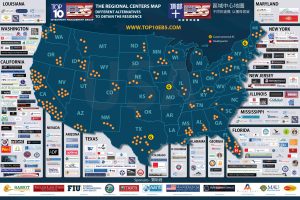The new E-2 visa bill and the difference in tax implications between E-2 and EB-5
As a proposed bill promises to offer a clear path to green-cards for E-2 investors, Dr Farooq elaborates on the tax implications of E-2 visas.
By Dr. Hussain Farooq
Copying any information from this article, whether partially or fully, is strictly prohibited without written consent of the author.
Despite the travel ban put by the current U.S. government and several other such factors, the U.S.A. still remains one of the dream places for many to immigrate to. Having one of the best healthcare, educational and life facilities, U.S.A. continues to attract entrepreneurs, businessmen and investors.
For entrepreneurs and investors, there can be different routes for immigrating to the U.S.A. each with its own set of advantages and disadvantages.
EB-5 (Employment-based fifth preference) Immigrant Investor Program continues to be a popular option among people from different countries wishing to obtain a Green Card, in particular from China which has resulted in a backlog for Chinese applicants.
While E2 category may not be well-known to some, it is a non-immigrant visa which can be a good alternate to EB-5 if an applicant wants to invest in the States and is from a country having a treaty of commerce & navigation with the U.S.A., however, as of now, it does not have a clear path to Green Card and/or U.S. nationality. Some of the basic differences between these two visa categories can be found here
Recently, U.S. Congressman John Rutherford introduced legislation to allow job creators who have been in the U.S. on an E-2 investor treaty visa for more than 10 years to apply for legal permanent residence. The bill, H.R. 3265, would also allow the children of these visa holders to remain in the country until they are 26 and apply for work authorization.
Before we review this bill, let’s first talk about E2 visa. This visa category is for the nationals of the countries with which the U.S.A. maintains a treaty of commerce & navigation. For the full list of treaty countries, please click here.
This allows the national of these countries to be admitted to the United States when investing a substantial amount of capital in a U.S. enterprise.
Investment Requirements for E2 Visa:
A minimum investment of approximately USD 200,000 (sometimes less) may be required to apply for a visa under this category

however this is dependent on the business involved. The USCIS has not set a minimum investment requirement but the regulations say that the investment has to be substantial in relation to the total cost of either purchasing an established enterprise or establishing a new one. Purchasing a franchise could be an option, too. In some cases depending on the nature of the business, the investment may have to be higher than the aforementioned amount.
The investment has to be an active investment and the business has to generate income for the applicant to get a renewal of his E2 visa. Certain employees of such a person or of a qualifying organization may also be eligible for this classification. Treaty investors and employees may be accompanied or followed by spouses and unmarried children who are under 21 years of age. The bill, H.R. 3265, would also allow the children of these visa holders to remain in the country until they are 26 and apply for work authorization.
While for globally-mobile businessmen and investors, having business interests in different countries and not wanting to actually make U.S. their permanent home, E2 visa is an interesting option as this does not require them to maintain a domicile in the U.S. which may also prevent them to be taxed on their worldwide income provided they do not spend more than a certain amount of time in the U.S. This provides them with the flexibility of traveling.
However, for other investors and entrepreneurs who leave their own country of residence, investing in a U.S. enterprise through E2 visa and start living in the U.S.A., the E2 route has a major disadvantage. It does not allow them to become lawful permanent residents of U.S.A regardless of how long they live in the U.S.A or how much of a contribution they make to the U.S. economy. Moreover, their children, upon turning 21, will no longer remain dependent under the U.S. laws and will have to either leave the U.S.A or may seek a change of status.
For someone who has come to the U.S.A. with actual plans of living there, has made a significant contribution to the economy, has paid in taxes over the years, has created jobs thus contributing to the society, not having the right to either become a permanent resident and subsequently not a citizen of the U.S., is something not very encouraging. It could be argued that such an individual and entrepreneur could have opted for a different visa category while coming to the U.S.A, such as EB-5. However, the fact of the matter is that there are some major differences between these two categories which sometimes stop entrepreneurs from applying under a category such as EB-5:

Under the EB-5 category, an applicant can either invest in a regional centre a minimum USD 500,000 or in a commercial U.S. enterprise for a minimum of USD 1 million while creating or preserving 10 full-time jobs for qualified U.S. workers. Regional centre investment is a) risky and b) not in one’s own control. The second option, that is an investment in a commercial U.S. enterprise, requires a substantial investment and not everyone is in a position to invest USD 1 million.
Hence, for such entrepreneurs, E2 provides a relatively feasible route to start a business in the U.S.A., however, not being able to apply for permanent residence is a major disadvantage of this route for many individuals, in particular who want to live in the States and want to contribute to the economy by paying taxes and by creating jobs. This bill, H.R. 3265, addresses the needs of those entrepreneurs and businessmen and tries to create equality among the different categories of investor-visa holders, as is the case in some other countries such as the U.K., Canada or Australia which are also among the top-favoured destinations for immigrants.
Let’s have a look at the U.K. visa categories for entrepreneurs and investors which can, somehow, be compared to E2 and EB-5.
Entrepreneur & Investor Visas from certain other developed countries:
The Tier 1 (Entrepreneur) Visa has also been a popular visa category among the entrepreneurs and businessmen from China, Russia/CIS, Pakistan, India & Middle East. It allows the entrepreneurs to get a renewable visa to the U.K. for an initial period of 3 years and 4 months. The entrepreneurs are required to invest a minimum of GBP 200,000 in a new or existing U.K. business. This category can somewhat be compared to the E2 visa of U.S.
The Tier 1 (Investor) Visa is another visa category for investors wanting to acquire residence in the U.K. and requires the investors to invest a minimum of GBP 2 million in the U.K. by way of government bonds, share capital or loan capital in active and trading UK registered companies (other than those principally engaged in property investment). This is a passive investment comparable in a way to the regional centre investment but with a difference in the amount.
However, in the U.K., regardless of what category is chosen by the applicant, permanent residence (indefinite leave to remain) and eventually citizenship can be applied for under both the categories. Canada, one of the most popular jurisdictions among the immigrants, also has different routes for entrepreneurs, businessmen and investors wanting to immigrate to Canada. The Provincial Nominee Program, the Quebec Immigrant Investor Program and the now-closed Federal Immigrant Investor Program all lead to Canadian citizenship upon fulfillment of conditions.
These programs, when compared to the U.S. programs, have differences in fine details but the essence is that in these countries, the entrepreneurs who invest somewhat less amount in an active business and investors who invest larger capital comparatively, are treated equally in terms of their rights to acquire permanent residence and citizenship eventually.
Tax Consequences under EB-5 and E2:
U.S. taxation is one of the most-powerful taxation system in the world. Introduction of FATCA further enhanced the

implementation of this taxation on U.S citizens and residents. U.S. taxation is a very broader subject and can not be covered under this article, however, a very brief overview is being given here of the tax-consequences under the EB-5 and E2 visa categories. Before jumping to the tax-consequences, it might be prudent to understand some basics:
U.S. citizens are taxed on their world-wide income. The U.S. alien residents are treated the same way, in terms of taxation, as the U.S. citizens. For the purpose of clarification, an alien is an individual who is not a citizen or national of that country. A nonresident alien is an alien who has not passed the green card test or the substantial presence test.
An individual can also be both alien resident and a nonresident alien in the same tax year, something referred to as a dual-status alien. It does not refer to dual citizenship, only to the resident status for tax purposes in the United States. In determining one’s U.S. income tax liability for a dual-status tax year, different rules apply for the part of the year one is a resident of the United States and the part of the year is are a non-resident.
Tax-consequences of EB-5:
Under the EB-5 route, the investors are granted a (initially-conditional) Green Card and hence, the investors are subject to taxation on their worldwide income as they pass the Green Card Test. This tax-consequence is sometimes a major deterrent for wealthy individuals to apply under this visa category.
Tax-consequences of E2:
E2 is a non-immigrant visa and hence, the alien does not become nor has the right to become a permanent resident of the United States, something this legislation has been introduced to defy. Not becoming a permanent resident of U.S., for taxation purposes, may be an attractive point for the globally-mobile affluent individuals who have business interests globally and reside in different countries but it is not a very advantageous point for many others who actually want to settle in the U.S.A.
One noteworthy point here, as mentioned above, is that for an alien, not holding a green card does not always prevent them from being considered as a resident alien or being taxed on their worldwide income. Even if an alien is not a green card holder but meets the substantial presence test for the calendar year (January 1-December 31), he may be considered as a resident alien for tax purposes in the United States and hence, may be taxed on worldwide income.
What is this substantial presence test and how to determine whether you will be considered a resident alien or a non-resident alien in terms of substantial presence test?
An individual will be considered a United States resident for tax purposes if he meets the substantial presence test for the calendar year. To meet this test, one must be physically present in the United States (U.S.) on at least:
- 31 days during the current year, and
- 183 days during the 3-year period that includes the current year and the 2 years immediately before that, counting:
- All the days one was present in the current year, and
- 1/3 of the days one was present in the first year before the current year, and
- 1/6 of the days one was present in the second year before the current year.
Let’s try to understand it with an example. If an alien, who wants to determine his tax status as a resident or nonresident alien for the year 2016 by taking the substantial presence test, has been present in the U.S. on 120 days in each of the years 2014, 2015, and 2016. To determine whether he meets the substantial presence test for 2016, count the full 120 days of presence in 2016, 40 days in 2015 (1/3 of 120), and 20 days in 2014 (1/6 of 120). Because the total for the 3-year period is 180 days, one is not considered a resident under the substantial presence test for 2016.
Any alien who meets the substantial presence test will be considered a U.S. resident for tax purposes and a U.S. resident alien’s income is generally subject to taxation in the same manner as a U.S. citizen.
Therefore, it is of utmost importance to seek a professional tax-advice before making an investment decision.
This article should not be considered as a tax, legal or immigration advice. It is a general opinion and the source of the information is the publicly available information. It is not meant to solicit any client, whatsoever, for immigration or tax planning purposes. Individuals who are interested in either applying for a U.S. visa or interested in obtaining a tax advice are advised to seek professional tax-advice from the qualified personnel and should not reply on opinions and general information. The author does not assume any liability, whatsoever, resulting from improper use or distribution of this article.
The article is written by Dr Hussain Farooq who is the president and CEO of HF Corporation, a consulting firm that is specialised in providing services for residence and citizenship by investment programs, around the world, to high net worth individuals and families who do not want borders to be boundaries for them. He regularly advises affluent families on strategies for effective citizenship and residence planning. The firm also has also developed a government-advisory practice to liaise with the different governments to build up strategies that could help in boosting FDI in their respective countries. HF Corporation can be reached at:
Email: info@hfcorporation.co


